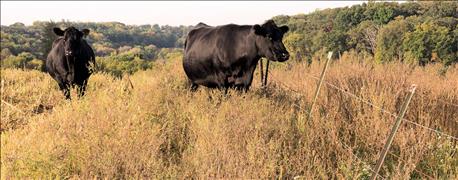July 27, 2016

Iowa County Extension agriculture agent Gene Schriefer reminds farmers and landowners to fertilize pastures according to soil test recommendations to maximize the benefits of seeding clover into existing pastures.
"Over time, managing for highly digestible forage and fertilizing according to soil test recommendations can shift the pasture species to a higher-energy mix suitable for grass-finishing cattle or growing dairy heifers," Schriefer says.
The reminder is part of the regional Grazing Broker project. More than 200 landowners and livestock producers in nine counties in Southwest Wisconsin are engaged to keep grasslands intact by decoupling land ownership and livestock management through contract grazing. For example, Mike Balch in Hollandale raises dairy heifers for a neighbor on the Balch Farm's pastures.

The pasture walk will follow-up on clover seeding in late winter by broadcast and no-till methods. A pasture tour and discussion will focus on results of tests of soil and plant tissue, fertilizer effects on pasture, and low-stress animal handling.
"The test plots of red clover that Mike broadcast and no-till planted in March are now visible, although the light green color of the leaves suggests that one or more nutrient deficiencies are limiting forage quality," says grazing broker Robert Bauer.
Livestock producers may face a dilemma between investing in pasture renovation and capturing greater pasture yield with a class of livestock with market demand but greater nutritional needs. Producers can use paired soil and plant tissue tests to identify which nutrient deficiencies to address first, which may reduce the cost of pasture renovation.
"Soil tests of Mike's pastures were low in phosphorus and sulfur in some spots," Schriefer explains. "Forages will yield up to their most limiting factor, in this case the macronutrient Phosphorus is limiting yield, but not quality. Plant analysis tests were high in phosphorus so the pasture is cycling nutrients effectively, but the leaf tissue is often low in both sulfur and calcium. Since soil pH is ideal we want to avoid ag lime as a calcium source in this case. Mike could address both the calcium and sulfur levels by topdressing gypsum. If Mike would like to produce additional forage yield, he could address the low soil phosphorus levels."
A pasture walk is scheduled Aug. 9 from 6:30-8 p.m. at the Balch Farm, 8712 Brue Road, Hollandale. The pasture walk will follow-up on clover seeding in late winter by broadcast and no-till methods. A pasture tour and discussion will focus on results of tests of soil and plant tissue, fertilizer effects on pasture, and low-stress animal handling.
The pasture walk is co-sponsored by Southwest Badger RC&D, Extension, and Peak Forage Products, LLC. The event is free and open to the public but RSVPs are requested by calling 608-732-1202.
The Grazing Broker connects landowners with livestock producers to keep grasslands intact and increase support for the restoration of additional productive grasslands. The project is supported by a grant from the National Fish and Wildlife Foundation.
Southwest Badger Resource Conservation & Development Council, Inc. is a 501(c)3 non-profit
organization working in the Southwest Wisconsin region. The organization's mission is to implement natural resource conservation and rural economic development in the area through education and best practices relating to agriculture, grassland, forests, and surface waters.
Source: Southwest Badger R, C & D
You May Also Like




